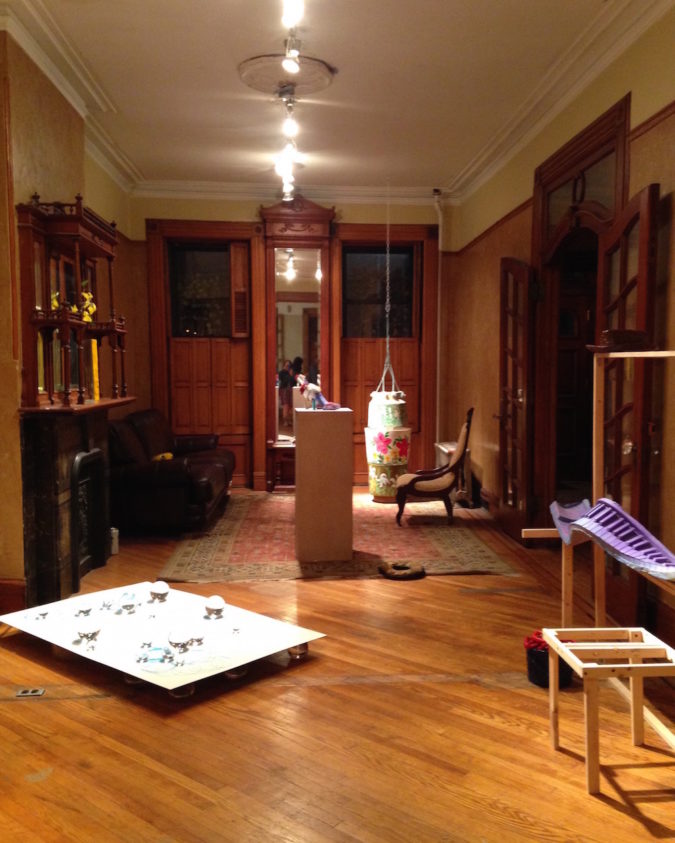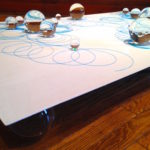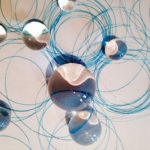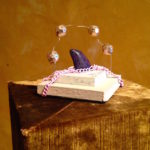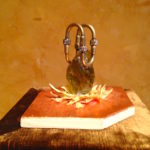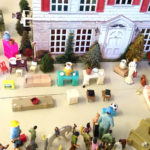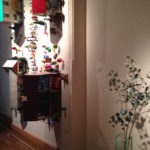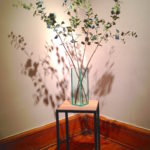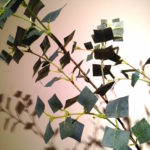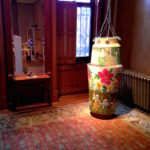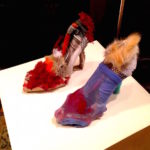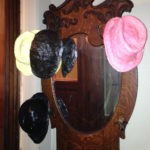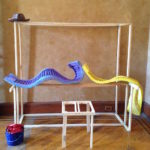What a World
“What a World, What a World” at The Parlour Bushwick
On a sunny Sunday in early November, visitors gathered for the reception of the exhibition “What a World, What a World” in the decorative elegance of the eponymous Parlour Bushwick (791 Bushwick Avenue, info@theparlourbushwick.com). The show, curated by Luisa Caldwell, was installed in the sumptuous elegance of the beautifully restored Gilded Age parlour of a Bushwick home, that in its heyday was probably host to its share of sparkling receptions at which well-dressed ladies and gentlemen glittered among collected objects of wonder in the brilliantly bright, newly installed electric light. This parlour was specifically designed to present both the magnificent and the domestic together, the wondrous and the unusual, the familiar and the uncanny. With the benefit of hindsight, however, it is impossible to imagine Gilded Age glamor without also remembering its shuddering substructure, its dark corners, and its deep insecurities. Lusia Caldwell’s sensitively curated exhibition somehow seems to encapsulate all of these feelings.
The individual works of art in “What a World, What a World” hold together in such a seamless narrative that walking into the exhibition felt like dropping into a world ready-made. The atmosphere at the reception was quietly ebullient; it was two days before the presidential election and people sensed an historic change in the air. The art that surrounded us seemed to support our optimism and hope: it was unusual, diverse, represented difference, revealed explorations of new ways of viewing familiar worlds, and almost seemed to presage a future of good triumphing over evil, competence over incompetence. Caldwell’s exhibition title is taken from the words uttered by the Wicked Witch of the West, after the triumph of Dorothy’s motley cohort of outsiders in the Wizard of Oz, as she melts into oblivion. As Caldwell notes, the witch’s capacity for amazement, even as she dissolved in her own retrograde miasma, seemed to stand for something larger in society, in life or in humanity, and also seemed to cohere in the several different strands of thought exemplified in the work of the artists in this show.
As befits their installation in a Gilded Age parlour, these sculptures talk to us about a culture and discourse of display in which things are more complicated than they appear to be on the surface.
Caroline Cox’s sculpture appears to represent either a macrocosmic or microcosmic universe in which clear and differently-sized crystal balls seem to function like celestial beings, planets, or atoms that spin on their own axes in their own orbits, with their lines of force or lines of trajectory sometimes intersecting and sometimes spinning independently and isolated. These solid but transparent bodies encircled by perfect thin blue incisive lines simultaneously suggest and undermine the possibility of connection and isolation, warmth and coldness, and imaginary or real, actual and meaningful transaction. The landscape on which this transitory world floats is flat, white and undifferentiated; the entire universe floats on even more transparent globes above the floor. It is as if nothing in this piece dares to touch anything else; exquisite fear and exquisite beauty coexist in this terrible harmony.
Harry Finkelstein’s sculptures also describe a miniature world constructed of geodes, natural rock, and found objects augmented with constructed pieces. These miniature sculptures sometimes appear to describe tiny landscapes, while at other times they suggest miniature abstract sculptures or hark back to commercial jewelry displays or even evoke bizarre little interior decoration schemes. Finkelstein’s sometimes crazy mixtures of elegant natural colors with cheap commercial costume jewelry colors, and even parts of actual costume jewelry—sometimes flat and dull, sometimes harsh and blazing—along with his frequently quite brilliant use of awkwardly clashing scales of objects—that oscillate at sometimes terrifying speeds—produce an uneasy sense of dissonance. The cultural attraction of the miniature, with its feminized and domestic associations, vies with the heroic and masculine sense of monumental (quite a feat in sculpture so small). Finkelstein imbues these works with a strange, surreal and deeply uncanny sense of significance.
Ron Baron’s wall piece, in which vintage doll houses and miniature figures are hung sideways on the wall like a mural, continues this increasingly familiar, yet increasingly uncanny narrative. Baron also uses the miniature to confound the viewer, but instead of alluding to the domestic and female, he refers to it directly by attaching four vintage tin doll houses (with stenciled pictures of the ideal houses printed on the tin). Three of the dolls houses seem to be “occupied” by doll families, but one appears to be empty. The doll’s furniture and possessions of this house are scattered around the front, side, and back of the house. A stream of miniature figures, comprised of “dolls” of various sizes, scales, and occupations, ranging from tiny plastic toy soldiers to Playmobil ™ figures in hardhats, to miniature plastic nuns, to small plastic babies, travel from the top of the sculpture toward and past the vacated house. We seem to be witnessing an eviction or a yard sale that no one wishes to acknowledge too closely. Some people peel off towards the vacant house, but most move on, steering a wide berth around the home’s contents as they pass. These toys are diverse, they are unalike but brought together and they move together, either unified or as a herd, it is not clear. The artist seems to be asking us to question the very premise of this imagined utopia—even in this imaginary that should evoke a nostalgic fantasy playland, even in this world that is managed by some Brobdingnagian artist, there are not just the seeds, but evidence of reality, and real dystopia.
Jane Benson also draws us in with the tease of the home and hearth. Her work is very much about activating feelings of nostalgia and home in her elegant arrangements of flowers or plants intended to decorate the corners of our rooms and brighten our homes. She then pivots her narrative to discomfit us. In the first piece, a bunch of lilies on the mantle piece, Benson literally gilds the lily. Benson’s art is premised on the idea that nature, while perfect in its creations, may be improved. She takes the kind of artificial flowers and plants that look so real that we often believe them to be so, and cuts the individual petals and/or leaves into unnatural, unusual, or geometric shapes, essentially rendering then “more perfect”. She works with such a degree of skill and subtlety that when we first see her new creations, we rarely notice that anything is “wrong” with them. It is only when the manufactured mutation is pointed out to us or we look carefully that we begin to realize how unnatural, how uncanny, and how truly disturbing these creations are. Benson seems to be able to intuit forms that are so synchronized to our visual desires that even when her flowers and plants are altered quite radically, we don’t notice immediately. Her transmutations bother us because they are still beautiful. The leaves of the “modified” plant, Faux Faux I are gorgeous in their simple elegance, but we cannot rid ourselves of an underlying, residual, uneasiness towards them; they press against some nerve in our psyche and leave us unable to give ourselves over to them completely. It is as if, by loving these reformed plants and flowers, we amplify and become complicit in the betrayal of the original.
Anna Rosen draws on domesticated themes in another way in her large sculpture “Root People”, exploring more fully the nature and function of memory. Her evocative sculpture is constructed from three large flower pots that she inherited among her late-grandmother’s belongings. Her grandmother had originally decorated all three pots with large, primitively painted flowers and trees. The three pots resonate with meaning and memory for both the artist and the viewer. As she constructed the sculpture to include these pots, Rosen shamelessly, but very elegantly rehearses the handicraft and home-based source of her found objects by piling the bottom two pots on top of one another and hanging the top one upside down from the ceiling using a makeshift macramé plant hanger. In this way, Rosen transports us along with her into the childhood world of her grandmother’s home that would otherwise be long abandoned to memory; she even leaves the flaking paint and slightly dusty unkempt surfaces of the pots untouched (they have even shed a bit of paint in the gallery). And, by adding, almost hidden in the interior at the bottom of the middle pot, a morbid miniature childhood death-scape of drying clay figures. These tiny clay corpses stand in for the kinds of figures that the artist apparently crafted as a child to occupy her time whilst her grandmother gardened, but they are now something much more sinister, more akin to actual corpses, and evocative of a much more adult, conscious killing field. The sense of a secure and homely domesticity at first so present in this sculpture gives way very quickly to an aching and almost heartbreaking desire for a time and place that is not only unrecoverable, but probably never existed in the first place, except in our memory’s imaginary.
“Hooker Shoes” Donna Huanca’s mutant high heels construct a very different visual space for objects traditionally associated with women within the parlour, one that is much more spectacular and deliberately attention grabbing. Huanca uses a pair of dramatically high fashion pumps as an armature or canvas, it is difficult to say since this piece rather moots the distinction, and she completely reconfigures both their form and meaning. Huanca’s incredibly smart use of a pair of shoes comments on some of the major cultural discourses of our day concerning the place of the visual in our world, the relationship between the work of art and the designed object, the relative artfulness of objects versus usefulness, the culture of spectacle, and the gendered object and image, to name but a few. The most appealing, timely, and obvious references are, of course, the sly, and very smart reference to Meret Oppenheim’s gazelle fur, a version of which escapes from the top of the left shoe, the very male Surrealist references to items of women’s clothing as sexual fetishes, our contemporary obsession with commodity fetishism and the presumptive dissipation of women’s energy in the adoration of shoes, which one sees displayed like so many pairs of millennial gods on similar pedestals in designers shoe shops, spotlighted in isolation, and worshiped in contexts that mimic that other sacred space–the museum! Huanca’s piece reveals how much the visual and its institutions are inter-permeable and in flux at present; it has been a century since artists breached the flat surface of the canvas as a legitimate site on which to paint, yet somehow it still feels transgressive to use a pair of shoes, a gloriously pedestrian surface, as an armature/canvas rather than a design surface. collapsed into a single complex web of interwoven meanings and messages that dance between the visceral, the cultural, and the intellectual. They create an immensely contingent work of art in which the incredibly contained and superbly communicated meanings always seem to be slipping and sliding just out of our grasp.
Finally, Matt Freedman & Jude Tallichet completed the parlour decoration with a full-sized ghost piano, whose dueling curling keyboards rise up to meet one another like wriggling worms of music. The temper of the player piano with its makeshift wooden frame, its barrel of laughs that grin brazenly and somewhat toothlessly to the front left of the piano, and the array of bowlers and trilbies that grace both the piano and the hat stand by the doorway, are at odds with both the visual aspect of the parlour’s genteel elegance and its cultural context as a Gilded Age home that was clearly intended to display economic and social status. The piano evokes the mad, seemingly random kind of music produced by a pianola, in which a cartridge determined the tune and the ‘player’ simply pedaled at the ‘correct’ tempo to produce the music. Frequently purchased by the aspiring lower-middle classes, such a pianola would have been a jarring mismatch in this parlour where the polite and aspiring middle-to-upper-middle classes engaged in highly structured, harmonic, social chit-chat and jockeyed with one another for social status. The barrel of laughs are too loud, the grins too wide, the hats set at too jaunty an angle, and the music probably played at too uneven a pace for this parlour. The keyboard can’t even stay where it is supposed to be: it has wriggled out of its confinement. This sculpture sums up many of the themes of this exhibition. It is funny and uproarious; it is familiar but uncanny, and it is welcoming and friendly, yet it is rife with anxieties that simmer just beneath the surface. There are ghosts that haunt this piece; they are the past and present ghosts of the material, emotional, intellectual and social dystopias just over the horizon, and they seem to emanate from this sculpture like heat. On the surface this pianola is breezy, funny, and oblivious. The tunes keep playing, even without a player, the laughs keep guffawing, and the music keeps on going, at least until the phantom canister rolls to a stop.
Parlours are the public space in the private worlds of one’s home. This complex nexus makes The Parlour Bushwick the perfect gallery to stage this challenging but beguiling exhibition. The various works of art in the exhibition seem to work together to present a glittering façade of cultural artifacts that mirror the eclectic collecting and display that we associate with some fictional trans-temporal Gilded Age lady whose patterns of desire and consumption (sort of) function(ed) as a synecdoche for early 20th, and now 21st century culture. Many of the works in this exhibition reveal an uneasiness, a disquieting undertone, and a sense of foreboding that might be read as parallels to the Gilded Age, but there is a caveat. How much are we swayed by context? Luisa Caldwell’s spectacular curatorial job brought together several complex, talented, and very individual works of art into a single exhibition to be read together through the lens of the exhibition’s title and statement. When I returned to think about the same show, after the presidential election, I thought about it through the lens of someone living in a very different world than a few days before. I saw darkness where before I had seen only light. I was looking at the same works of art by the same artists. While we all know that great works of are capable of holding multiple meanings simultaneously and of functioning differently in different, we also know that the malleability of potential meaning makes great art complex, living works of art, which at times can be profound and at times can be amusing; we know that these things make great art a marvelous, wondrous thing. Yet, I can honestly say that I had not previously experienced such a profound change in so short a time. It was sobering, but it was also profound and enlightening. It made me appreciate the works in this exhibition and Caldwell’s curatorial skills even more than I had at first. Finally, as I wrote this, I began to wonder if I had overplayed my references to the Gilded Age, but then I thought that, if she were here, Edith Wharton would have loved the long, convoluted tale of our recent election and its cast of characters. I wonder what she would have said about it? Her brilliantly-barbed velvet tongue would have produced something much better, no doubt than Frank L. Baum’s “What a World, What a World”, but it is nonetheless a pretty good start.
